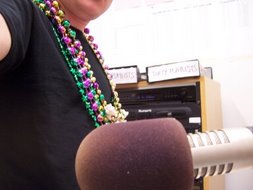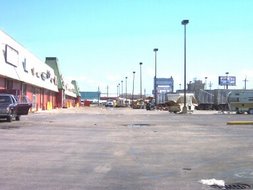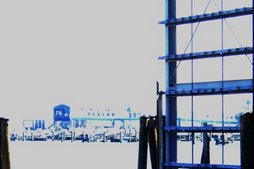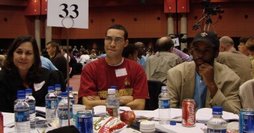 Big Box Retail in the New Orleans Resurrection
Big Box Retail in the New Orleans ResurrectionA Jacuzzi sits in a white cardboard box in a big box retailer at the crossroads of two major paths through New Orleans. All the promise of nightly relaxation and a steamy end to the day fits inside a 5’ tall container, in a row of containers exactly the same, in a giant outlet of similar promises in wildly varying sizes and shapes. In a city of warped devastation and spreading reconstruction, the Jacuzzi awaits a new home, one fish in a pond stocked to the brim.
This particular Lowes sits on Elysian Fields, at the on-ramps to I-10, the highway that cuts East-West through the southern states. As it is every day, the parking lot is full of pick-up trucks (many of them with Texas plates) and 18-wheelers and small swarms of Hispanic day laborers. As I pull in, I notice, for the second time in a week, a guy in a purple, gold, and green—the Mardi Gras colors--striped shirt waiting for work. After two days of heavy thunderstorms, the mid-November sky is brutally clear, the temperature a crisp 60 degrees.
As I enter the building, I pass a line of fake X-mas trees. The season sure starts early these days. A block of grills follows the trees, as it’s always grilling season down here.
I turn into an aisle and find a row of new lawn mowers splayed out like grounded veloci-raptors. The next aisle features bathroom fixtures, from toilets to sinks to lamps that light up when I pass. Three small fans offer high, medium, and low speeds and I test the volume on each by pressing a button.
Next up is kitchenware, with several rows of ovens, some of which have “Look Inside” printed on the door. Inside: very spacious, indeed. Most ovens cost $400-500. Two lines of refrigerators face each other like sentinels, all black or white or chrome. “Over the Range” microwaves run around $300. Above me hangs a sign designating this section as “Appliances,” with smaller, sub-headers that read “Kitchen Project Center,” “Laundry,” and “Cooking & Refrigeration.”
I move over to the Project Center and peruse the samples for kitchen counter tops. Some names: “Tundra Quartz,” “Venetian Sand,” “Haze Agate,” “Spanish Paprika,” “Tapioca Pearl,” “Celebration Granite,” the last of which is a black flecked with red, yellow, and pink. Granite tile can run you anywhere from $60-80 per sq. foot.
Over in Wallpaper, I scan the many options, from a Grecian look that includes faux-cracked paint, pillar-tops, and olive branches, to a “Finding Nemo“ print for the kids. "Midnight Train to Georgia“ plays somewhere overhead. Other possible wallpapering: Southern Hospitality, Yankee Ingenuity, Coastal Vitality, and Heartland Charm.
I wonder what Gutted Lakeview would look like. What strikes me about all this variety and plenty is that, in a way, everything piled on these shelves and organized into sections and sub-sections is a shadow inventory of what was lost. Anything at Lowes represents a replacement for something taken by water, wind, or fire during and after the storm. At the same time, these vanity tops ($98) and showerheads ($68-$340) represent improvements on the past, each fresh and brand new and a sliver of dream house, the details that a homeowner chooses once the slate is scrubbed clean or demolished. Sure, the exact same Lowes exist across the country, but down here the promise is different, the balance between want and need even more out of whack.
The people who pass me are as varied as the shelving units and light bulbs. Dressed mostly in the flannels and boots of remodeling, the shoppers might be carpenters or roofers or carpetbaggers or homeowners. There’s no way to tell, because everyone who owns property is in the same boat, differentiated by resources but drawn to the same well of supplies. There’s a mix of optimism and confusion in the air, perhaps because many people are embarking on re-building with very little expertise or experience; they just have no choice. You notice a hesitation as a young couple scans a length of pole for the proper size and fit -- some shoppers never considered such things before. And all across the city and region now you see people working away at their houses, with a wide fluctuation in the damage but the same let’s-get-on-with-it attitude. At this point, a year after the storm, there’s little choice but to go ahead and do it yourself. That’s a new thing here.
While the majority is black, the shoppers here today are diverse group, in various combinations of old and young, teams or lone soldiers with steely focus. Machismo is usual in a hardware store, but the boldness and slight cheer in this place is definitely contextual. People move about, trying to find the right pieces, taking advice from employees who probably haven’t been on the job all that long. Hell, the amount of mistaken advice and returns is likely higher here, too, but I’m sure the sheer volume of buying covers that hassle for the store. Consumers’ demands are endless; everything is necessary.
The week before this visit to Lowes, Kim and I attended the District 2 United New Orleans Planning Meeting, a gathering for residents to discuss plans for the neighborhood’s future. District 2 is unique in the diversity of its components: the Garden District, Lower Garden District, Milan, Touro, Irish Channel, and Central City. These areas represent both some of the wealthiest (the Garden District with its mansions) and the most crime riddled (Central City with its almost nightly shoot-outs). We live in the Lower GD, a freakier, slightly more broke-down section abutting the piers along Tchoupitoulas Street.
The meeting took place in a battered community center on Jackson Avenue. H3 Studio had set up a series of maps of District 2, color-coded to represent variations in population, storm damage, crime, and other demographic measures. We sat at roundtables and listened to a man with a Dutch-sounding accent describe the neighborhoods and plans for possible rebuilding. When he was done, he instructed each table to discuss the 3 scenarios he’d outlined: RePair, ReHab, and ReVision. These plans represented escalating degrees of community action, government funding, levee building, and reinvention.
Aside from Kim and I, the people at our table were middle-aged: one black man, one white man, and one white woman. As we pored over the scenarios, each laid out on a map, it became evident that we all shared a basic hope of commercial resurgence, fair housing, and strong, urgent action on the levees. When it was time for the tables to present their favored plan, 1, 2, or 3, the general consensus stressed similar hopes. One specific common desire, originally listed in both the ReHab and ReVision plans, was the transformation of S. Claiborne Avenue from the dilapidated 4 lane strip of fast food joints and random retail stores running from downtown to uptown, into a major commercial thoroughfare, possibly lined with a streetcar or light rail line. It’s an innovative thought, but almost every table that mentioned it added that big box stores should not be part of the new equation. Before the storm, New Orleans was distinctive in its prevalence of independent small businesses, however weak the general economy was. At this meeting, most people—a crowd of perhaps 120 made up of blacks, whites, and a few Latinos, leaning towards the middle-aged but with no shortage of younger folk—wanted that characteristic to return, along with a renewed desire for fair housing and storm protection. I’d bet, though, that most of them had shopped at a big box retailer in the last week. Lowes has 6 stores in the New Orleans area, Home Depot has 9; you’d be hard pressed to avoid them if you’re trying to start your life over.
And that’s the Catch-22 underlying so much of the progress taking place today in New Orleans: people want to bring things back as directly and swiftly as possible, but they’re fearful of wiping out the very reasons that made them want to live here and why they chose to return. We’ll never fully get back to business-as-usual, the city as we knew it, but the other choice can’t be business-as-usual as it runs in the rest of the country, with the leveling affect of national chains and lifestyle standardization. In a neighborhood as distinctively diverse as District 2, such homogenization would kill the very beauty the residents gather to save. Big-box retailers operate at the heart of this dilemma.
My favorite place in any hardware store/home improvement outlet is the lighting section, in this case Specialty Lights. The accumulated warmth of the many types of lamps and sconces and track lighting always makes me feel dreamy, like we’re finally inside a house, perfectly lit by a thousand well-aimed bulbs and shades. The mutations of product names are pretty sweet, too: Brushed Nickel Cosmopolitan Chandelier: $78. Antique Pewter Mini Pendant: $43. For outside the house, you can pick up a piece of Solar Accent Lighting; for example a 10-inch glowing squirrel powered by a small solar panel on his tail. Or maybe you want a few frogs for the landscaping, you know? Adjacent to the lighting hangs an orchard of ceiling fans, only 2 of them spinning.
I walk on past all things doors—hinges, locks, knobs, knockers, and doors themselves. I pass safes with traditional and digital locks, fireproof. Incongruous groupings in some aisles place shop-vacs across from ladders and tow-cables. “Plumbing: you have a call on 6100,” says the intercom. Stacks of insulation burst through the packaging stand next to treated deck wood and fascia. Even new, the florescent overhead lights on display look old and bug-stained. In the window aisle, Phil Collins comes through the speakers and I squeeze between the stacks.
Passing through the dazzling botanical diversity of the Garden Center (“3 Gallon Podocarps $12.98,” “6 inch Lily Asiatic Hybrid: $5.85”), I return to the parking lot. Along the main drive, a line of flatbed 18-wheelers sits stacked to the top with sheet rock. On the other side of them, in the adjacent BP gas station parking lot, someone has set up a large, wood-burning grill that gives off the smell of ribs. Picnic tables stand empty, it’s still not quite lunchtime, and a man and woman work on a large sign advertising the ribs. I walk back to the car and sit in the baked heat. Across Elysian Fields, a Baptist Church promises “Jesus is Lord over New Orleans,” next to a gutted animal clinic. In the neutral ground, a road sign for I-10 dangles upside down.
I drive past the BBQ pit and through the crowd of day laborers surrounding the BP station (Mardi Gras guy still there) to the Carnival Club & Casino, a cinder block and sheet metal box painted up in Mardi Gras colors. The casino appears very new, likely erected at the same time as the Lowes, a pretty smart idea, I think. I park and enter the small lobby, where a large security guard waves me down with a metal-detector wand and lets me enter the bar. The room is relatively dim, with a pool table in the back and two flat screen TV’s mounted above the long square bar.
I order a Bud draft, the girl behind the bar teases me about liking draft beers and I tease her about all the foam in my cup, cost $1.50. Near the entrance, there’s an older white woman wearing Mardi Gras beads and on the other side of me an older black man eats his lunch from a takeout container. Apparently he’s employed there.
We watch The Contender, the reality show featuring amateur boxers. Each episode is like Rocky (Sylvester Stallone co-founded the series), with each boxer telling his story, which features his wife and family and desperation for the big-time. Today’s installment features a Latino fighter versus a white fighter, the former talking a lot of cheesy shit about the white guy’s cushy upbringing. I’m there just in time for the fight, and I’m taking the white guy because he’s got a very broken nose and because the Latino guy seems to be a little overconfident. The man next to me picks the Latino guy, but changes his mind several times during the fight. Commercials for video games, Monday Night Football, and beer break up the 5 rounds. It’s a hell of a fight, but the final round and the fight goes to the white guy, who has a little more energy for the final 2 minutes.
I say my goodbyes and walk over to the casino, which is in fact a dark, rather small room crammed with video poker machines and a few slots. This is the kind of place that bankrupted South Carolina in the 1990’s, I think, a closet of low-stakes desperation with 2 employees. It’s mostly women at the machines, a couple of men making their way through the cramped aisles. Everyone has that zoned-out look of electronic gamblers, but there’s nothing very different or seedy in here, just people taking minor chances in the dark. I leave, telling the security guard to take care, and exit into the glare of the parking lot. The Lowes stands across the asphalt expanse, busy as a beehive.
The customer base of the casino is the same as the Lowes, or at least it figures, being as they’re right next to each other and the casino feels like a bird on the back of the Lowes hippo. As long as you’re dreaming, the casino whispers, why not test fortune? But construction supplies, all the parts that go into rebuilding homes and businesses, they’re not mere bits of chance. If anything, it’s the opposite: at this point, there’s nowhere to go but forward, however risky that is, and the materials better be sure things and plentiful. And however fucked up the insurance and the government money is (which is a whole other story in mud and grays), people decide that they need to pick up their tools and put their lives back together again. Some might not know how, some might be doing it in service of others, but new buildings will rise from this effort, pieced together from the shelves of places like Lowes.
(An important side note: you only see individuals at work, never anything governmental, local or military-driven. At the community meeting, they told us that they need to define the parameters of a “100-year hurricane” before they can start building a levee to prevent a “100-year hurricane.” So the return as it stands lays in the hands of the people, assisted only with money from the various agencies, but no direction, certainly no attention on a national scale. Bush barely mentions the place, Mayor Nagin is wholly absent, and the money goes into the cash registers at Lowes, the broken system continues its wobbly march.)
Will the provider swallow up the very lives it spawns? Will the big-boxes turn to pillars and thus smotherers of the economy? Maybe. At the same time, “what are you gonna do?” The awesome sight of so many people re-building in every neighborhood of the city, the singular feeling of thousands of sets of hands at work, the sound of hammers in street after street, what room does all that leave for reservations? Right now, people in NO need supplies so that they can start their lives over. Big box retailers like Lowes provide that. The question is, what will life (and livelihood) look like if it’s created in the image of such giants? Where will people work? How much will they make and what will they spend it on? Will dingy video poker sheds be the riskiest diversions in town? Change and progress are here, in every shape, vision, and price-point possible. But an equally deep selection of outcomes--shiny or scuffed or tucked in the corner--is yet to be determined.












